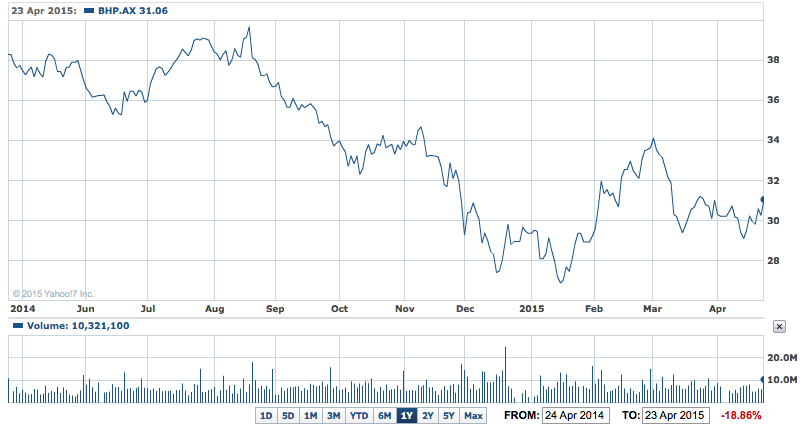BHP Billiton (BHP) shares fell yesterday after the company’s March quarter production and sales update and news that it was cutting spending on its iron ore expansion – but would still reach its target, but more slowly.
Normally you’d expect investors to greet news of a cut in spending by a resource major to be good news – but somehow this news (the cut to spending wasn’t quantified) wasn’t seen that way. BHP shares fell more than 1.7% at the opening to under $30. They later recovered, then dipped again to end the day at $30.07, down 1.7%.
BHP 1Y – BHP plots a ‘slower path to system capacity’

BHP said in its production report that it would slow capacity expansion in its Western Australia iron ore operations, after production in the nine months to March 31 increased 16% year-on-year and sales jumped 15.6%.
BHP also lifted its forecast for the amount of iron ore it would produce this year, despite the 54% plunge in the price of the commodity over the last year.
It revised up its 2015 full-year production guidance to 230 million tonnes, 2% above its previous guidance.
On a 100% basis, taking into account joint venture partners, BHP lifted its Australian iron ore output guidance to 250 million tonnes, also up 2%.
BHP said it was pushing out the timetable to expand its iron ore output to 290 million tonnes a year, and because its operations were performing ahead of expectations, BHP said it was now possible to defer a project to increase the handling capacity at Port Hedland.
“While this will lead to a slower path to system capacity of 290 million tonnes per annum (Mtpa), it will come at a lower capital cost," BHP said in the March quarter report.
“In iron ore, our focus remains on producing at the lowest possible cost with Western Australia iron ore unit costs now below $20 per tonne as we continue to improve productivity,” Chief Executive Andrew Mackenzie said in yesterday’s report. (Notice that BHP now says the cost of mining and shipping its iron ore to Port Hedland is now under $US20 a tonne.)
Mr Mackenzie said his teams continued to exceed expectations to deliver strong operating performances.
He defended the miner’s iron ore strategy against a wave of recent criticism, saying that over the last decade, China’s demand growth provided BHP and Australia with a unique opportunity.
“We acted swiftly to bring on new iron ore capacity at some of the lowest costs globally, generating long-term value for shareholders, the government and communities which would otherwise have been lost to overseas competitors,” Mackenzie said.
“Despite the subsequent increase in supply-side competition, these low-cost expansions continue to deliver attractive margins and returns through the cycle,” he said.













